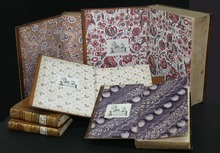Intent (book production)
The endpaper (also: endpaper or endpaper, formerly also bookbinder leaves ) of a book connects the book block front and back with the book cover and looks like a double page folded in the middle.
function
The primary purpose of the attachment is to connect the cover to the book block in order to stabilize the book. The endpaper also covers the inside of the book cover and protects the first ( half-title page) and last sheet of the book.
construction
A header consists of a double sheet folded in the middle . The two halves of the double sheet are called cardboard sheet (in the case of attachments with a visible fabric fold, it is the mirror ) and flying sheet . In a hand-bound book, the endpaper is usually held in place by a narrow fold that encompasses the first sheet. Simplified end-pieces are connected to the first or last layer of the book block by means of a folding strip. Modern industrial book products, especially the softcover version , often no longer have a flyleaf because of the advanced simplification.
- The Anpappblatt is the part of the header paper sheet is bonded to the inner side of the book cover. It is also known as a mirror sheet or mirror .
- When Flying leaf (also flying intent ) refers to the other, loose half of intent that the half-title is preceded and thus, as not part of the book block, when pagination is not considered.
For special types of binding there are also different types of attachment, which take into account the particularities of the corresponding type of binding. Jump back book , Franz tape or the Danish millimeter tape require special attachment variants. The double header described above is the standard header used for most books. As a rule of thumb, the more bibliophile a work is, the more extensive the intent is.
Quality and features of the paper
When leafing through a book, the endpaper is particularly stressed in the fold area . For this reason, a strong, tear-resistant paper with high opacity is chosen for the endpaper . Usually natural paper or ribbed paper is used, which has a weight of between 100 and 130 g / m².
The end paper is sometimes given its own color and / or is printed, for example with geographical maps or other images, graphics or drawings that match the book or its content. In the 18th and 19th centuries, marble and, more rarely, moiré papers were used for the endpaper . At the present time, similar or differently patterned papers are only used for the endpaper in particularly high-quality, mostly hand-bound books.
literature
- Helmut Hiller, Stephan Füssel: Dictionary of the book. 6th edition. Klostermann, Frankfurt am Main 2002, ISBN 3-465-03220-9 .
- Ursula Rautenberg (Hrsg.): Reclams Sachlexikon des Buches. Reclam, Stuttgart 2003, ISBN 3-15-010542-0 .
- Rainer Groothuis: How do books come to earth? About publishers and authors, manufacturers, sellers and designers, the calculation and the retail price, the beautiful book and related things. 2nd Edition. Dumont, Cologne 2002, ISBN 3-7701-3164-9 .
See also
Web links
Individual evidence
- ^ History of the City of Winterthur: edited according to documents, vol. 8; Johann Conrad Troll; P. 289

